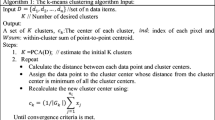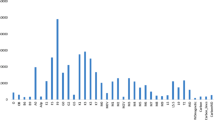Abstract
The stellar spectral data taken by LAMOST (Large Sky Area Multi-Object Fiber Spectroscopic Telescope) include multiple types, some of which that fall between two spectral classes, namely boundary spectra. Due to the massive and high dimensional nature of spectra data, it will take a lot of time and energy to cluster these spectra by manual operation alone. To address this problem, a new clustering method based on influence space is presented in this paper. First, we introduce the concept of influence space to reduce the amount of data involved in the operation, and reduce the dimension of the data by extracting the main feature lines. Second, a novel method for initial cluster center selection is applied. Next, based on the selected initial cluster centres, other spectra are clustered by running K-means algorithm on the whole data set. The experimental results indicate that the initial cluster centres obtained by this method are of higher quality and the problem of boundary spectra clustering is also well solved.








Similar content being viewed by others
References
Cui X. Q., Zhao Y. H., Chu Y. Q. et al. 2012, Res. Astron. Astrophys., 12(9), 1197
Deng C. H., Zhao W. L. 2018, arXiv preprint arXiv:1804.04312
Deng L. C., Newberg H. J., Liu C. et al. 2012, Res. Astron. Astrophys., 12(7), 735
Hu J., Li T., Luo C. et al. 2017, Knowledge-Based Systems, 132, 144
Li Y. 2011, Pattern Recognition Lett., 32(11), 1517
Li Y., Cai J., Yang H., Zhang J., Zhao X. 2019, IEEE Access, 7, 74683
Liu D., Nosovskiy G. V., Sourina O. 2008, Pattern Recognition Lett., 29(9), 1261
Liu X. W., Zhao G., Hou J. L. 2015, Res. Astron. Astrophys., 15(8), 1089
Luo A. L., Zhao Y. H., Zhao G. et al. 2015, Res. Astron. Astrophys., 15(8), 1095
Mansheng X., Zhe X., Zhicheng W. et al. 2017, J. Electronics & Information Technol., 39(5) 1123
Qiu B. Z., Yue F., Shen J. Y. 2007, Pacific-Asia Conference on Knowledge Discovery and Data Mining, Springer, Berlin, Heidelberg, pp. 761–768
Radovanović M., Nanopoulos A. et al. 2014, IEEE Transactions on Knowledge and Data Engineering, 27(5), 1369
Santhisree K., Damodaram A. 2011, in International Conference on Electronics Computer Technology, IEEE
Sheikholeslami G., Chatterjee S., Zhang A. 1998, VLDB’98, pp. 428–439
Sheng-Sheng W., Da-You L., Bin C. et al. 2005, Computer Applications
Tong Q., Li X., Yuan B. 2017, Pattern Recognition Lett., 89, 1
Yang J., Estivill-Castro V., Chalup S. K. 2002, in Proceedings of the 9th International Conference on Neural Information Processing, ICONIP’02. IEEE, vol. 2, pp. 898–903
Yang H., Qu C., Cai J. et al. 2020, IEEE Access, 8, 80978–80996, https://doi.org/10.1109/ACCESS.2020.2990801
Zhang X., Liang X., Li B. 2011, in The Fourth International Workshop on Advanced Computational Intelligence, IEEE, pp. 209–212
Zhao G., Chen Y. Q., Shi J. R. et al. 2006, Chinese J. Astron. Astrophys., 6(3), 265
Zhu F., Ye N., Yu W. et al. 2014, Neurocomputing, 123, 166
Acknowledgements
This work is supported by the National Natural Science Foundation of China (Grant Nos U1731126 and U1931209) and Shanxi Province Key Research and Development Program (Grant Nos 201803D121059 and 201903D121116). The Large Sky Area Multi-Object Fiber Spectroscopic Telescope (LAMOST, now called the Guoshoujing Telescope) is a National Major Scientific Project built by the Chinese Academy of Sciences. Funding for the project has been provided by the National Development and Reform Commission. LAMOST is operated and managed by the National Astronomical Observatories, Chinese Academy of Sciences.
Author information
Authors and Affiliations
Corresponding author
Rights and permissions
About this article
Cite this article
Cai, J., Li, Y. & Yang, H. A new method for clustering of boundary spectra. J Astrophys Astron 41, 15 (2020). https://doi.org/10.1007/s12036-020-09634-x
Received:
Accepted:
Published:
DOI: https://doi.org/10.1007/s12036-020-09634-x




